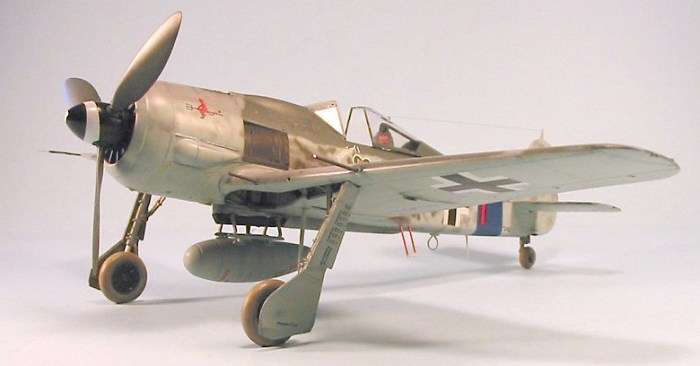
|
KIT: |
Hasegawa 1/32 FW-190A-8 |
|
KIT # |
08071 |
|
PRICE: |
¥4200 (about $40 US) |
|
DECALS: |
Two options |
|
REVIEWER: |
Tom Cleaver |
|
NOTES: |
Uses some of the 190D-9 sprues |

|
HISTORY |
The Fw-190A-8 Wurger was the most-produced sub-type of the radial engined Anton series of Kurt Tank’s classic design. Introduced into production at the end of 1943, it featured the increased armament of the Fw-190A-7, with the fuselage-mounted 7.7mm machine guns replaced by 13mm MG 131 weapons, with four MG 151 20mm cannon mounted in the wings. With minor modifications for heavier armament for the bomber-destroyer role, this aircraft would serve until the end of the war on both the Eastern and Western Fronts.
Normandy: Graveyard of the Luftwaffe
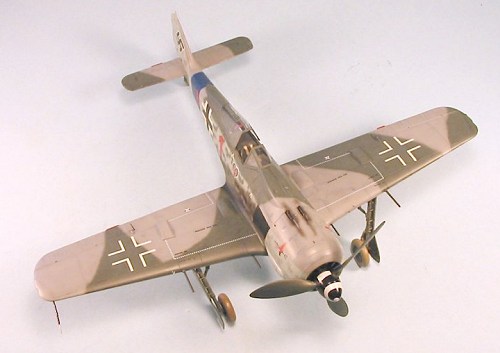 When the
Allied armies landed on the Normandy peninsula on June 6, 1944, there
were fewer Luftwaffe aircraft to oppose the invasion than had been
available two years earlier at the time of the Dieppe Raid. JG2 -
the unit assigned to the Cherbourg Peninsula since 1941 - was widely
dispersed, with the nearest unit being I/JG2, commanded by
Major Erich Hohagen, which had only recently returned from the
fighting at Anzio. 20 of the unit’s Fw-190A-8s engaged a raid of Ninth
Air Force B-26 Marauders over Pointe du Hoc during the initial phase of
the invasion; this would be the biggest battle fought with the
Luftwaffe on the first day. II/JG2 with Bf-109s was at Creil
outside Paris, while III/JG2's Fw-190s were in the process of
transferring to Fontenay-le-Comte north of La Rochelle.
When the
Allied armies landed on the Normandy peninsula on June 6, 1944, there
were fewer Luftwaffe aircraft to oppose the invasion than had been
available two years earlier at the time of the Dieppe Raid. JG2 -
the unit assigned to the Cherbourg Peninsula since 1941 - was widely
dispersed, with the nearest unit being I/JG2, commanded by
Major Erich Hohagen, which had only recently returned from the
fighting at Anzio. 20 of the unit’s Fw-190A-8s engaged a raid of Ninth
Air Force B-26 Marauders over Pointe du Hoc during the initial phase of
the invasion; this would be the biggest battle fought with the
Luftwaffe on the first day. II/JG2 with Bf-109s was at Creil
outside Paris, while III/JG2's Fw-190s were in the process of
transferring to Fontenay-le-Comte north of La Rochelle.
The other Channel Geschwader, JG26, was even less ready to meet an invasion. II/JG26 was now based at Mont-de-Marsan south of Bordeaux, while I and III Gruppen were in transit near Reims and Metz respectively. JG26's Kommodore, Oberst Josef “Pips” Priller and his wingman, Unteroffizier Heinz Wodarczyk, were the total combat-ready force of JG26 in the invasion area. Priller’s bravura low-level dash along Sword Beach has been memorialized in the book and movie, “The Longest Day.”
Altogether, the Luftwaffe managed to mount 170 sorties over the beachhead on June 6, a figure that is insignificant in comparison with the 14,000 sorties flown by the Allied air forces that day. By the end of the day, all three Gruppen of JG26 were in the invasion area, and 2./JG26's Staffelkapitaen, Oberleutnant Franz Kunz, had shot down a P-51 of the 4th Fighter Group.
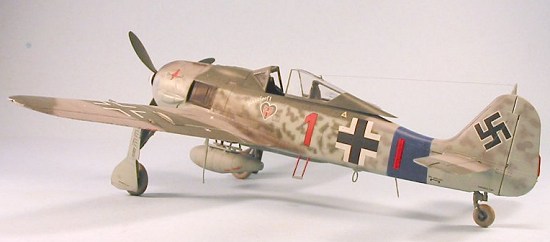 After the
previous five months of combat with the ever-increasing Allied air
forces, the Kanalfront Geschwadern had already lost the majority
of their experienced pilots, and the units were composed primarily of
young enlisted flyers with less than 100 hours total time, most of whom
were barely able to control their Focke-Wulfs and Messerschmitts in level
flight, let alone in high-G close-in low-level fighter-versus-fighter
low-level combat. The units from Germany, with experience fighting bomber
formations, would be even less-prepared for what they met over the
invasion front. They were all about to be thrown into a cauldron from
which the Jagdwaffe would emerge a largely-spent force.
After the
previous five months of combat with the ever-increasing Allied air
forces, the Kanalfront Geschwadern had already lost the majority
of their experienced pilots, and the units were composed primarily of
young enlisted flyers with less than 100 hours total time, most of whom
were barely able to control their Focke-Wulfs and Messerschmitts in level
flight, let alone in high-G close-in low-level fighter-versus-fighter
low-level combat. The units from Germany, with experience fighting bomber
formations, would be even less-prepared for what they met over the
invasion front. They were all about to be thrown into a cauldron from
which the Jagdwaffe would emerge a largely-spent force.
In the
following 36 hours, 200 Fw-190s and Bf-109s were flown in from Germany,
leaving the Reich with only six fighter groups to defend against the
Allied bombing offensive. By the end of June, 950 single-seat fighters
had been fed into the invasion battle. While the fighters had flown in,
the ground crews were sent by road and rail, and suffered delays and
casualties from Allied air attacks. Most units deployed from the main
French bases to smaller, better-camouflaged forward landing strips.
Under attack on the ground and in the air, the Jagdflieger suffered 230
pilots dead and 88 wounded by July 1, with 551 aircraft shot down and a
further 65 destroyed on the ground. They gave as good as they could, for
instance, on June 10, Oberleutnant Addi Glunz, Staffelkapitaen
of 6./JG26, a 60-victory experte and Kanalfront “alte Hasen”
(old hare), 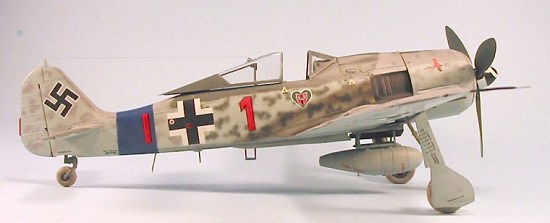 shot down three P-47s in a low level combat in 2 minutes and
30 seconds. JG26 would score 150 victories between June 6 and
their arrival back in Germany on September 3, but they would lose nearly
100 of their own in the same time.
shot down three P-47s in a low level combat in 2 minutes and
30 seconds. JG26 would score 150 victories between June 6 and
their arrival back in Germany on September 3, but they would lose nearly
100 of their own in the same time.
Among the other units fed into the Normandy killing ground was 2 Staffel of JG54, which was brought directly from the Eastern Front to join III/JG54, which had been serving in the Reich since 1942. Among the pilots of the unit was Leutnant Hans Dortenmann, a former infantry officer who had transferred to the Luftwaffe in 1942 and had joined the unit a year previously, following graduation from flight school. Dortenmann had scored his first victory on the previous February 6 when he rammed a Lavochkin La-5; by the time he arrived in Normandy, Dortenmann had 15 victories in the East and was a leading member of the unit. Between June 10 and June 26, 1944, Dortenmann - flying his Rot Ein - would score six more victories before being shot down south of Paris on the 26th. Dortenmann survived the crash and flew on through the rest of the invasion campaign until 2./JG54 - which became 12./JG54 and a component of III Gruppe on August 10 was withdrawn along with the rest of the unit to Achmer, where they became the first Jagdgruppe to equip with the new Fw-190D-9. Flying on through the campaign in Western Europe, Dortenmann survived to be awarded the Ritterkreuz on April 20, 1945, for 35 hard-won victories in difficult circumstances. He flew his last combat mission on April 27, shooting down a Yak-3 over Berlin. With a total 18 victories while flying the Langnasen Dora, he was the leading experte on the type.
|
THE KIT |
Hasegawa’s 1/32 Fw-190D-9 is rightly acclaimed as the best Langnasen-Dora kit currently available. This kit of the Fw-190A-8 takes its place as the best kit of the radial-engine variant currently available.
 The kit shows
the influence of the 1/48 DML Fw-190 kits in the design of the engine
cowling; however, this cowling looks to be far easier to assemble than
the DML offering. The kit shares the same wing and undercarriage
assembly - other than having a completely enclosed wheel well - with the
earlier Dora kit, which means it is virtually foolproof when it comes to
getting the gear legs installed at the correct angles. The cockpit is
sparse in comparison with what one can get in resin aftermarket sets, but
given that the cockpit is not that visible once completed, it is more
than adequate for all but the most addicted resin-a-holic. The only
aftermarket bit I could suggest would be the Cutting Edge posable resin
seat belts, since the seat is the most-visible item in the cockpit in the
completed model. The windshield and flat-top canopy are very clear and
of scale thickness.
The kit shows
the influence of the 1/48 DML Fw-190 kits in the design of the engine
cowling; however, this cowling looks to be far easier to assemble than
the DML offering. The kit shares the same wing and undercarriage
assembly - other than having a completely enclosed wheel well - with the
earlier Dora kit, which means it is virtually foolproof when it comes to
getting the gear legs installed at the correct angles. The cockpit is
sparse in comparison with what one can get in resin aftermarket sets, but
given that the cockpit is not that visible once completed, it is more
than adequate for all but the most addicted resin-a-holic. The only
aftermarket bit I could suggest would be the Cutting Edge posable resin
seat belts, since the seat is the most-visible item in the cockpit in the
completed model. The windshield and flat-top canopy are very clear and
of scale thickness.
The kit provides both lower wing ejection chutes for the 20mm MG 151 cannons and the 30mm MK 108. This means that a modeler would not have great difficulty in turning the kit into an Fw-190A-8/R2 Sturmbock for those who can’t wait for Hasegawa to re-release the kit in that version in coming months.
Decals are provided for two aircraft, that flown by Leutnant Hans Dortenmann of 2./JG54 during the Battle of Normandy in the summer of 1944, and the Anton-8 flown by Feldwebel Rudolf Artner of 9./JG5 in Norway during early 1945. These are the new-style Hasegawa decals where the white is really white, rather than ivory, making the decals very useable. Those who are challenged in painting and masking the Reichverteidigung bands will be happy to know that decals are provided for these items.
|
CONSTRUCTION |
What can I say? This kit goes together like a Tamiya kit and ends up looking as accurate as a DML Fw-190.
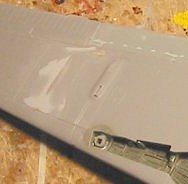 “Follow the
instructions” is the only advice you need here. The only difficulty I
had was in getting rid of the seams along the rear and outer edges of the
under wing plate that has the outer cannon servicing panel and ejector
chute. I sanded it down, applied Mr. Surfacer, sanded some more, and
eventually covered the bloody seam with Cyanoacrylate glue, sanded that
down and covered it with the third attempt using Mr. Surfacer. I think I
would have had less trouble had I test-fitted the parts and sanded down
their interior sides until they fitted closely, which would then have
required nothing more than some Mr. Surfacer 500 to make the seam go
away.
“Follow the
instructions” is the only advice you need here. The only difficulty I
had was in getting rid of the seams along the rear and outer edges of the
under wing plate that has the outer cannon servicing panel and ejector
chute. I sanded it down, applied Mr. Surfacer, sanded some more, and
eventually covered the bloody seam with Cyanoacrylate glue, sanded that
down and covered it with the third attempt using Mr. Surfacer. I think I
would have had less trouble had I test-fitted the parts and sanded down
their interior sides until they fitted closely, which would then have
required nothing more than some Mr. Surfacer 500 to make the seam go
away.
Several
modelers have noted that the drop tank provided in the kit is incorrect
for the Fw-190A-8, and they are right. At the same time I was doing this
kit, I started in on a ProModeler release of the Hasegawa Bf-109G-4; the
drop tank in that kit is for the Bf-10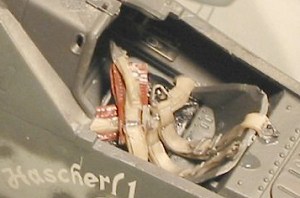 9G-6,
and not correct for the earlier version. It is, however, correct
for the Fw-190A-8, and the new kit’s tank is correct for the earlier 109.
A quick swap-out solved the drop tank problem for both projects.
9G-6,
and not correct for the earlier version. It is, however, correct
for the Fw-190A-8, and the new kit’s tank is correct for the earlier 109.
A quick swap-out solved the drop tank problem for both projects.
The kit cockpit is a bit sparse, but the truth is that the Fw-190 cockpit was very clean and pretty sparse anyway - and beyond that you can’t see much in there when it’s completed and in position. I used the kit decals for the instrument panels; they went down easily under Micro-Sol and look fine once the kit is assembled. The only thing one really notices in a completed Fw-190 cockpit is the seat. I used Cutting Edge posable resin seat belts and I think the result looks good. This was the only aftermarket addition to the model.
|
COLORS & MARKINGS |
Painting:
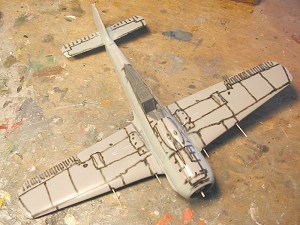 After
pre-shading the model, I painted the Reichsverteidigung stripe
with Tamiya X-4 Blue and then masked it off. I then painted the lower
surfaces with Gunze-Sangyo “RLM76" Lichtblau. I used Gunze-Sangyo
“Medium Sea Grey” for RLM75 Grauviolett, and finished with
Gunze-Sangyo “RLM 74" Grau-grun freehanding a standard Fw-190
camouflage pattern, and dappling the fuselage sides with RLM75 and RLM74
per the kit painting diagram.
After
pre-shading the model, I painted the Reichsverteidigung stripe
with Tamiya X-4 Blue and then masked it off. I then painted the lower
surfaces with Gunze-Sangyo “RLM76" Lichtblau. I used Gunze-Sangyo
“Medium Sea Grey” for RLM75 Grauviolett, and finished with
Gunze-Sangyo “RLM 74" Grau-grun freehanding a standard Fw-190
camouflage pattern, and dappling the fuselage sides with RLM75 and RLM74
per the kit painting diagram.
The kit shows the airplane with a yellow panel on the lower cowling. However, the spiral on the spinner dates the airplane to later than June 15, when this identification marking was instituted on the Western Front. At the same time, colored cowling panels were deleted as an ID marking and over-painted. I had painted the yellow panel before checking this in my research, so I over-painted it in such a way that - in person - one can see a few “holidays” (old Navy term for a not-so-good coat of paint) through the RLM76 over-paint. All these colors were lightened with post-shading by adding a bit of Tamiya “Sky Grey” to each mix and going over individual panel lines.
Once all was dry, I gave the model a coat of Future.
Decals:
I used the kit decals, which went down with no problems with a double-application of Micro-Sol on the larger ones.
|
FINAL CONSTRUCTION |
 The one
photograph I have found of this airplane shows that it was pretty close
to factory-new when it arrived in Normandy. Since it only survived for 16
days, I didn’t ding it that much, though I did apply a dark exhaust
stain, from Dortenmann having running that BMW 801 at full power in
combat - the engine had a notoriously “dirty” exhaust under max revs.
The one
photograph I have found of this airplane shows that it was pretty close
to factory-new when it arrived in Normandy. Since it only survived for 16
days, I didn’t ding it that much, though I did apply a dark exhaust
stain, from Dortenmann having running that BMW 801 at full power in
combat - the engine had a notoriously “dirty” exhaust under max revs.
I attached the landing gear, which is so “fool proof” in its design that one would have to put serious effort into screwing the pooch in order to not get the landing gear installed at the right angles. I unmasked the windscreen and canopy, and glued the canopy in the open position. I used nylon repair thread for the antenna wire.
|
CONCLUSIONS |
This is one of the best kits it has been my pleasure to work with. Like I said, it assembles like Tamiya and looks like DML when finished. A first-timer could turn out a nice model from this kit.
I must admit, these Hasegawa 1/32 kits have definitely gotten under my skin. They’re beautiful when finished, accurate in outline, and - for what you get - cheap at the price. I bet you can’t build just one! I know I can’t, not with the aftermarket decals I know are in the production pipeline. Let’s see, what was that cost estimate for adding an extra wing to Le Chateau du Chat....????
April 2004
Thanks to HobbyLinkJapan for the review kit. www.hlj.com
If you would like your product reviewed fairly and quickly by a site that has over 250,000 visitors a month, please contact me or see other details in the Note to Contributors.